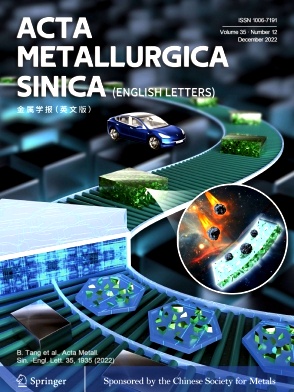
Acta Metallurgica Sinica(English Letters)
- 期刊详情
- 栏目设置
- 期刊荣誉
- 期刊文章摘录
- 相关期刊
- 点评详情
 期刊投稿1-3月见刊
期刊投稿1-3月见刊 订阅咨询一站式咨询服务
订阅咨询一站式咨询服务 杂志投稿在线杂志订阅
杂志投稿在线杂志订阅 发表咨询专人持续跟踪服务
发表咨询专人持续跟踪服务
期刊详情
- 期刊介绍
- 主管单位:中国科学技术协会
- 主办单位:中国金属学会
- 出版地方:辽宁
- 快捷分类:工业
- 国际刊号:1006-7191
- 国内刊号:21-1361/TG
- 邮发代号:
- 创刊时间:1988
- 发行周期:月刊
- 期刊开本:16开
- 下单时间:1-3个月
- 业务类型:杂志服务
Acta Metallurgica Sinica(English Letters)简介
《Acta Metallurgica Sinica(English Letters)》(ISSN 1006-7191, CN 21-1361/TG) started in 1988. It is administrated by China Association for Science and Technology, sponsored by the Chinese Society for Metals, and managed by Institute of Metal Research, Chinese Academy of Sciences. Beginning with V.22 (1) 2009, this publication was indexed/abstracted in Science Citation Index Expanded.
《Acta Metallurgica Sinica(English Letters)》 provides an international medium for the publication of theoretical and experimental studies related to the fields of metallurgy, materials science and engineering. The studies which advance the understanding of the relationship between the processing, the structure and the properties of inorganic materials are of particular interest. Emphasis is on either the mechanical or functional behavior of inorganic solids at all length scales down to nanostructures.The journal does not seek or publish papers on concrete and cement-based systems nor on polymeric and polymer-based materials.
杂志文章特色
1.Abstract
The abstract should be no longer than 300 words. It should be informative, without descriptive words or citations, and contain the major conclusions and quantitative results or other significant items in the paper. Together with the title, the abstract must be adequate as an index to all the subjects treated in the paper, and will be used as a base for indexing.
2.Keywords
Immediately after the abstract, provide a maximum of 6 keywords.
3.Mathematics
Variables should appear in italic text. Vectors should appear in bold italic text. Capital and lower-case letters should be distinguished clearly where there could be confusion. Fractional exponents should be used to avoid root signs. Extra symbols should be introduced to avoid complicated exponents or where it is necessary to repeat a complicated expression a number of times. The slash (/) should be used wherever possible for fractions. Mathematical derivations that are easily found elsewhere in the literature should not be used.
4.Notation
Notation must be legible, clear, compact, and consistent with standard usage. All unusual symbols whose identity may not be obvious, including subscript or superscript, must be made comprehensible. Physical and mathematical variables should be in italic, vectors in boldface. Units, abbreviations and special functions should be upright. Please add notes to explain any other special symbols.
5.Units
Follow internationally accepted rules and conventions: use the international system of units (SI).If other quantities are mentioned, give their equivalent in SI.
6.Figures
Format: High-resolution figures must be uploaded during manuscript submission. The preferred format for figure submission is TIFF format (*.tif).
(1). Image Size: An image intended for the journal's double column format (i.e., an image to fit into the space of a single column on the 2-column layout), should be sized to 6.5 cm. Images submitted for a layout that spans full columns (i.e., an image that will occupy the full-page width) should be sized to 13.5 cm, and complicated figures should have a maximum width of 15 cm. In the figures, the main lines should be about 0.3 mm in width, and the assistant lines 0.15 mm. Notations in the figures should be distinct and consistent with the same ones in the text, and their font size will be 8-10 pt.
(2).Image Resolution: Line drawings and graphs must have a resolution of at least 1200 dpi when they are exported. Photographs and micrographs must have resolution of at least 300 dpi (600 dpi if there is text or line art in the figure). Please use LZW compression (which does not affect resolution) when saving figure files. Lower-resolution images will not reproduce properly and will not be accepted.
(3). Color: Submit color graphics in CMYK format; the colors chosen must reproduce effectively and the colors should be distinguishable when printed in black and white; The descriptions of figures in text and captions must be sufficiently clear for both online and print copy.
7.Tables
Tables, numbered in order of appearance, should be appended on separate sheets and identified with appropriate titles. The table title, which should be brief, goes above the table. A detailed description of its contents or table footnotes should be given directly below the body of the table.
8.References
References must be published work, and numbered consecutively in order of their first citation. References should be listed individually at the end of the text and indicated in the text with a superscript number in square brackets. All of the authors, as well as the titles of the reference articles should be given. It is strongly recommend that authors try to employ the recently published articles, and it is appropriate that more than 50% references are published in the recent three years. Here are some examples of how to set the most common reference types:
(1)References to journal publication:
[1] J. van der Geer, J.A.J. Hanraads, R.A. Lupton, J. Sci. Commun. 163 (2000) 51–59.
[2] Y. Zhang, L. Ren, M. Li, X. Lin, H.F. Zhao, K. Yang, J. Mater. Sci. Technol. 28 (2012) 769–772.
[3] W. Strunk Jr., E.B. White, The Elements of Style, third ed., Macmillan, New York, 1979,pp. 25–32.
[4] J.Q. Yu, Atlas of Binary Alloys Phase Diagram, Shanghai Scientific and Technical Publishers, Shanghai, 1983, pp. 334–339.
(3)References to a chapter in edited books:
[5] G.R. Mettam, L.B. Adams, in: B.S. Jones, R.Z. Smith (Eds.), Introduction to the Electronic Age, E-Publishing, Inc., New York, 1994, pp. 281–304.
[6] Y. Sawaragi, S. Hirano, in: M. Jono, T. Inone (Eds.), Mechanical Behavior of Materials, Pergamon Press, London, 1992, pp. 589–594.
(4)Reference to proceeding:
[7] F. Masuyama, L.B. Adams, in: Proceedings to the 4th International Conference on Advances in Materials Technology for Fossil Power Plants, Hilton Head Island, South Carolina, U.S., October 25–28, 2004.
(5)Reference to dissertation
[8] X.H. Ma, The Preparation and Property Research of Hydroxyapatite Flurescent Nano Particle, Ph.D. Thesis, Wuhan University of Technology, 2007. (in Chinese)
[9] K.L. Corwin, A Circularly-polarized Optical Dipole Trap and Other Developments in Laser Trapping of Atoms, Ph.D. Thesis, University of Colorado, 1999.
(6)Reference to patent
[11] C.G. Bai, L. Murr, W. Smith, A Novel Method for Preparing Al Base MMC, US Patent, No. 200101133, 2001.
(7)Reference to online literature
[12] H.R. Sheikh, Z. Wang, L. Cormack, A.C. Bovik, Live Image Quality Assessment Database Release 2, http://live.ece.utexas.edu/research/quality, September 8, 2006.
杂志分析报告
年度被引次数报告(学术成果产出及被引变化趋势)
年度期刊评价报告(本刊综合数据对比及走势)
注:年度总文献量的统计不包含资讯类文献,如致谢、稿约、启事、勘误等
注:比率 = 当年基金资助文献量 / 当年发文量 * 100%
注:当年发文量的统计不包含资讯类文献,如致谢、稿约、启事、勘误等
Acta Metallurgica Sinica(English Letters)栏目设置
Special Issue:Friction Stir Welding and Processing,HIGH TEMPERATURE STRENGTH OF MATERIALS,REGULAR PAPERS,Special Issue_PREFACE,PREFACE,Special Issue
Acta Metallurgica Sinica(English Letters)荣誉
Acta Metallurgica Sinica(English Letters)收录
期刊文章摘录
- 免费
咨询 - 订阅咨询
- 期刊推荐
- 联系电话发表咨询:023-6549-4411
订阅咨询:023-6033-8768



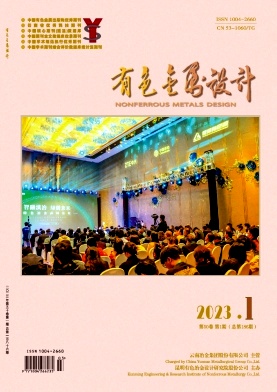
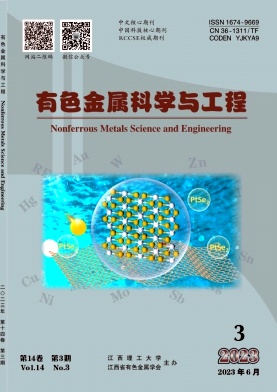
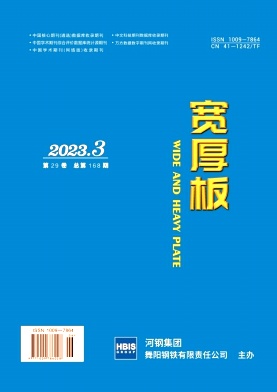
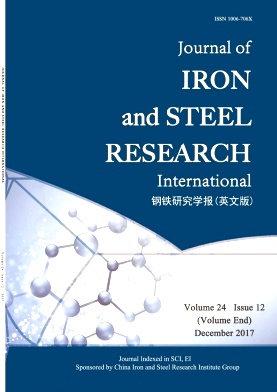
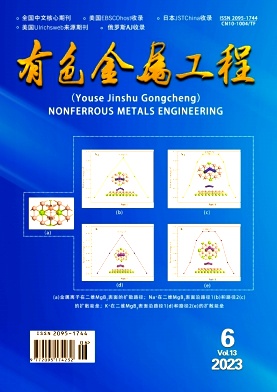


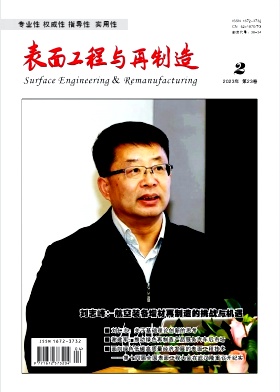

点评详情